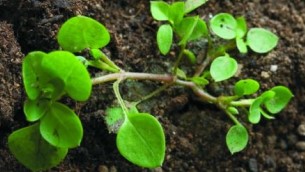Broad-leafed Dock
Rumex obtusifolius
Broad-leafed docks (Rumex obtusifolius) grow prolifically throughout New Zealand. This is the most common dock weed found around farmyards, in damp arable & pasture land, wasteland and gardens.
The leaves are very large and broad (up to 35 cm long and 15 cm wide) hairy underneath, and have long stems. The plant can grow to 1 m tall. Flowers appear from July to April and are usually small, green (sometimes red) and inconspicuous, carried above the leaves in clusters. The root is a strong thick perennial taproot, enabling easy regrowth. Seeds are a reddish brown.

Cotyledons:
- Apex rounded
- Base tapered
- Stalkless
Leaves
- Broad oval
- Round tip
- Base flat












